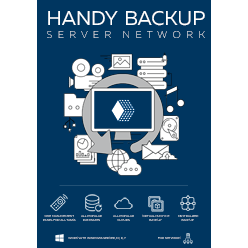Database Backup Tools
Database backup tool by Handy Backup simplifies the crucial task of securing business-level data by effortlessly capturing snapshots from every existing DMBS. With a range of generic and dedicated tools, Handy Backup ensures efficient and cost-effective db backups without imposing significant efforts or expenses.
Looking for reliable database backup solutions? Try Handy Backup today with our free 30-day trial version! Safeguard your valuable data effortlessly and explore the full potential of our software.
Version 8.6.2 , built on April 17, 2025. 118 MB
30-day full-featured trial period
List of Supported Databases
This tool captures snapshots of MySQL databases and tables, generating readable sets of SQL commands that facilitate the restoration of the original MySQL datasets.
The specialized tool is capable of backing up Microsoft SQL Server of any version (MSSQL 2019, 2017). It can preserve entire databases, tables, SPFILE, and Controlfile.
Handy Backup utilizes a specialized tool to back up PostgreSQL databases, tables, and schemas, enabling the backup of both local and distributed PostgreSQL databases.
The Oracle backup feature relies on an internal backup utility called RMAN, ensuring complete compatibility with the Oracle API. It can natively back up and restore Oracle data.
The MariaDB backup feature enables users to create and restore a sequence of MariaDB SQL operations, facilitating the restoration of backed-up tables. Similar to MySQL, it supports multiple engines.
The IBM DB2 backup plug-in is a solution that enables the creation of hot and cold DB2 snapshots, along with the capability to restore and replicate DB2 databases in a native API mode.
The plug-in for backing up IBM Notes (formerly known as Lotus Notes and Domino) files and tables facilitates quick and secure access to IBM Notes database information and ensures effective restoration of taken snapshots.
Backing up Cacti with Handy Backup software is remarkably easy and highly efficient, thanks to its MySQL plug-in.
Generic Tool Using ODBC - Database
Maximize the potential of ODBC backup for any existing DBMS with a standard, generic plug-in known as "Database". This versatile feature enables you to back up both SQL and non-SQL data repositories:
- Sybase backup– preserving popular SAP structures locally or on a server.
- Firebird Backup – safeguarding copies of various Firebird datasets.
- FoxPro Backup – saving table content from the widely-used desktop DBMS.
- MS Access backup – capturing snapshots of the popular Microsoft Office data.
Hot and Cold Database Backup Tools
There are two primary approaches to backup database:
- Hot backup involves copying data using the database's APIs. While slower than cold backup, it doesn't necessitate stopping the DBMS server. It allows for transaction-safe db snapshots, preserving ongoing business activities.
- Cold backup requires you to stop your DBMS and allow it to dump all data from memory to the hard disk, after which you can back it up using the usual file system copying method. Although this method results in server downtime, there are situations in which it can be exceptionally effective.
For example, if you have a Master-to-Slave replication configuration, you can safely shut down the Slave, back up its files, and then restart it.
All database backup plug-ins in Handy Backup are designed to retrieve data without interrupting database services, i.e. perform hot backup. The program can be used on both physical and virtual servers, and all operations can be scheduled to run daily or at intervals of your choosing.
Schedule backups, enable email notifications, and always rest assured knowing that your data is protected.
Replication and Clustering
Replication
Replication allows you to distribute the database across multiple servers and assign each server its own role. One server interacts with applications in the usual manner, while others serve as read-only copies.
If one server fails, it doesn't result in a complete loss of service for your applications. Additionally, you can reconfigure a Slave Server to act as a Master, and vice versa, at any time.
Note: While replication configuration enhances uptime and accessibility of your databases, it cannot replace backups. Therefore, if your master were to accidentally crash, all changes would be automatically replicated to slave instances.
Clustering
The same holds true for clustering configurations, where multiple servers (SQL nodes) operate as one entity without specific roles. Clusters typically rely on distributed storage engines, ensuring that the failure of any node does not lead to data loss.
Unlike replication configurations, clusters do not facilitate long-distance database distribution but offer higher I/O speeds and improved response times. As a general rule, it is always advisable to combine replication or clustering configurations with regular database backups.
Licensing Information
There are two business-level editions of Handy Backup, both equipped with a comprehensive set of database backup plug-ins and other valuable features. For database backup solutions, consider either the Small Business or Server Network editions. Take advantage of our free 30-day trial!
Video Demonstration of Database Backup
In this video, you will witness an exemplary database backup carried out using the PostgreSQL plug-in. You'll gain insight into saving and restoring PostgreSQL tables while leveraging the full spectrum of features offered by Handy Backup, presented in a step-by-step manner.
Handy Backup for Hosting Providers
We are a very open company, and look forward to partnership opportunities with businesses from all fields of IT, including OEM, service providers, integrators, and other. Our solutions are already used by several web hosting providers who use it to back up databases of their clients.
If you would like to join our partner network, or discuss details of potential co-operation, please refer to the Partners section.
See Also:
Cnet Editor’s Rating:

Outstanding

